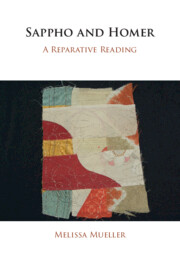Book contents
- Sappho and Homer
- Sappho and Homer
- Copyright page
- Dedication
- Contents
- Acknowledgments
- A Note on Texts and Abbreviations
- Introduction
- Part I Reparative Reading
- Part II Sappho and Homer
- Chapter 3 Plaiting and Poikilia
- Chapter 4 Aphrodite and the Poetics of Shame
- Chapter 5 In the Bardo with Tithonos
- Chapter 6 Sappho fr. 44V, or Andromache’s “No Future” Wedding Song
- Chapter 7 Sappho’s Third Alternative
- Chapter 8 Sapphic Remembering, Lyric Kleos
- Epilogue
- Appendix On the Absence of the Newest Sappho Fragments from this Book
- Works Cited
- Index Locorum
- Subject Index
Chapter 5 - In the Bardo with Tithonos
from Part II - Sappho and Homer
Published online by Cambridge University Press: 07 December 2023
- Sappho and Homer
- Sappho and Homer
- Copyright page
- Dedication
- Contents
- Acknowledgments
- A Note on Texts and Abbreviations
- Introduction
- Part I Reparative Reading
- Part II Sappho and Homer
- Chapter 3 Plaiting and Poikilia
- Chapter 4 Aphrodite and the Poetics of Shame
- Chapter 5 In the Bardo with Tithonos
- Chapter 6 Sappho fr. 44V, or Andromache’s “No Future” Wedding Song
- Chapter 7 Sappho’s Third Alternative
- Chapter 8 Sapphic Remembering, Lyric Kleos
- Epilogue
- Appendix On the Absence of the Newest Sappho Fragments from this Book
- Works Cited
- Index Locorum
- Subject Index
Summary
This chapter offers a new reading of Sappho’s Tithonos Poem, and turns to Sedgwick’s “bardo” writings as a framework for exploring the feeling of suspension that characterizes Sappho’s poem. Sappho’s lyrics respond to the absences and silences in epic, as well as to what is more explicitly there. Often, the body in Sappho can be understood as providing cues for the voice, with symptoms arising within the body prompting the singer’s recall of certain mythical parallels. In the Tithonos Poem, for example, the singer’s sense of heaviness in her limbs prompts her recall of the mythical figure Tithonos, the ever-aging yet deathless lover of Dawn. It is argued that the singer’s own groaning lament becomes intertwined with that of Dawn for Tithonos, but it also potentially channels Achilles’ mourning for Patroklos. Sappho ventriloquizes the voices of Homeric characters. This has been acknowledged in the case of Helen but as this chapter argues, Achilles’ mournful lament also provides a surprising and powerful zone of contact between the worlds of epic and lyric.
Keywords
- Type
- Chapter
- Information
- Sappho and HomerA Reparative Reading, pp. 109 - 131Publisher: Cambridge University PressPrint publication year: 2023



